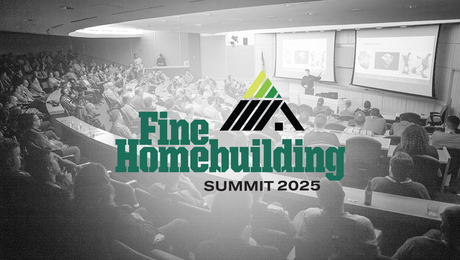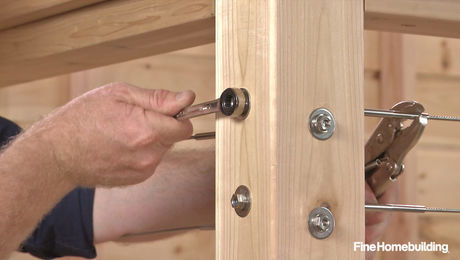I removed an attached deck earlier this year due to excessive rot from a poorly flashed ledger board. I have repaired the rot and resided the house with verticle ship lapped rough cedar. I am ready to rebuild the deck but am unwilling to cut into the siding. What is the best way of attaching the ledger board over the cedar siding? Should I space it away to avoid trapping water?
Help
David



















Replies
David,
You can build the deck "freestanding". Build a drop beam that runs about 10 or 12 inches from the house and leave a small gap with the decking. Be sure to brace the drop beam to the joisteses.
you don't need a ledger. Build it free-standing on it's own legs independent of the house. A few challenges arise in the stabilization of the deck with diagonals but it's well worth it.
Whenever the question of deck ledgers comes up here there are always suggestions that the deck be built free standing. I'm not saying it's a bad idea, but does anyone have an example of a free standing deck more than a couple of feet off the ground? I'm beginning to think that in practice building a braced deck that is solid and doesn't look like hell is a lot harder than it seems in theory.
I agree. Use a PT ledger, bolted to the building, a membrane behind it that is correctly "shingled" into the house waterproofing and a metal "Z" flash on the top of the ledger. I just went back to a house I built in 1983, all PT ledgers, beams and posts. House has cedar siding with a second story deck and the reason I was there was to look at replacing the Red Cedar decking after 25 years. The ledger, house wall, posts and beams are all still as good as the day I put them up. Yes the decking and some railing needs replacement.
They can't get your Goat if you don't tell them where it is hidden.
"a membrane behind it that is correctly "shingled" into the house waterproofing"So what method would you use for this that is already sided?If I am attaching where there is siding, I remove it and weave the membrane in and flash over, but this guy does not want to do that. One of the best details for what he is looking for that appeals to me is one that I have seen leave a lot of rot behind that I had to repair - not my work originally, but I was impressed with the concept in theory. It just didn't work in the long run
Welcome to the Taunton University of Knowledge FHB Campus at Breaktime. where ... Excellence is its own reward!
<< One of the best details for what he is looking for that appeals to me is one that I have seen leave a lot of rot behind that I had to repair - not my work originally, but I was impressed with the concept in theory. It just didn't work in the long run >>
What are you talking about here Piffin? I don't get which method you are referring to...Justin Fink - FHB Editorial
I did not stipulate it because I was not recommending it.It was a place where they had run lags through the ledger, then thru a 1" or so of ABS black pipe as a bushing, then in through the siding ( cedar shingles) into the rim joist, with caulk at the point of penetration.There was tarpaper behind the cedar shingles, the caulk at the ole, the compression fitting nature of the plastic bushing that suspended the ledger away from siding, and still there was a completely rotted through rim.I was going to include a photo or two of the nasties for you, but apparently I have that on some older archived CD from the old PC. Not finding it in my photos file here.there has also been discussion of a method for this that employs a newer product - kind of looks like a cross section of railroad tie or I-beam. Aluminum.
It has holes drilled in the flanges so that you put I%W shield on the sheathing, then bolt this thing to the wall over the I&W. The ewb is vertiaclly aligned and the second flange is something like 3-4" away from the wall and it also has holes predrilled. siding can be run up and around this product, and flashed and caulked. Then the ledger is bolted to it.I like the idea of this, because the flashing and sealing is all at least as good as any other fenestration openning.My other preferred attach method is to use a beam oriented perpendicular to the house and framing joists parrallel to the house and then the decking is oriented perp to lead water away from foundation.That reduces the number of penetrations to the siding and it can be flashed well.The overall problem with attached decks IMO, is that it is harder to deal with sealing the penetration than with doors and windows or vents, because the penetration is in a location where it tends to see more water and to trap that moisture in place. For instance a window is higher in the wall and protected somewhat by the roof overhang, and water is freely flowing down away from it. By contrast, water striking a deck wants to puddle there briefly and to splash up onto the siding. Where no gutter directs runnoff away from the deck, there is added volumn from the roof. Moisture is retained tot he ledger connections when snow piles and ice remains in winter. so a ledger connection gets more water and stays wetter than penetrations such as windows, yet we treat these nearly the same or sometimes more carelessly when we should be treating them like roofing where water can puddle - with extreme care.
Welcome to the Taunton University of Knowledge FHB Campus at Breaktime. where ... Excellence is its own reward!
http://deckbracket.com/
An excellent looking idea.
View Image
Edited 8/15/2008 1:00 pm by jagwah
Would you use the deckbracket with a stucco exterior?
I've been contemplating, but wonder about corrosion and sufficient space to allow the ledger attachment once the stucco application is complete.
To the OP (sorry for the highjack) - as a homeowner, I would seriously consider using this product to avoid the extra posts on a free-standing deck if it is at a second story level.
Edited 8/15/2008 1:52 pm ET by Varoom
with a verticle download of 1000-1100lbf there pretty strong and they're aluminum.
Mostly with stucco I might fear any movement which seems unlikely. It comes down to sealing the bracket in to prevent any water penetrationbehind the stucco.
Looks,frankly, better than some other ways I've seen.
Gee, you'd think I could've recalled a name like that!;)
Welcome to the Taunton University of Knowledge FHB Campus at Breaktime. where ... Excellence is its own reward!
how's the AL work with current PT chemicals?
With stucco, any reason not to bolt the ledger through the stucco and flash the top of the ledger?You don't want to cut the stucco .... right?Jeff
You know, I don't know.
But ever since the trouble with ACQ and all the corrosion issues I've just been slobbering everything with strips of butyl rubber. The stuff used to flash windows. I find it a good habit,maybe unnessesary, but a bit of insurance against a call back.
I like to run the stuff over the tops of my joicing before I deck. And any other place I feel water may degrade my framing.
how's the AL work with current PT chemicals?@@@It should go away in short order.Copper is 0.30v on the anodic index. AL is 0.75 or .90v. If you are looking for a 0.15 difference between the two metals, you don't have it. <http://www.engineersedge.com/galvanic_capatability.htm>The ToolBear
"I am still learning." Goya
oh, I see. YOu didn't explain on purpose...I just got confused by that.
The I-Beam product you mention is called Maine Deck Bracket. It is a very neat product, and it's strong enough that you can space them out on something like 4 foot centers. Pretty impressive.
Justin Fink - FHB Editorial
Edited 8/15/2008 3:26 pm ET by JFink
Well, since he is "unwilling" to cut into the siding I would suggest he
pray for the willingness to cut into the vertical siding. ;-) The killer in his case is the vertical siding. No way to slip any flashing under the siding above the ledger. That pretty much means one relies on a sealant for the water proofing.
There is nothing wrong with a free standing deck but I agree with fingersandtoes that they often look bad and are more work than attaching one with a properly done ledger.
If I HAD to attach a ledger under his circumstances I would take maybe 6"x12" pieces of Ice and Water fold it in half sticky sides out with a pre-drilled piece of 1/2" steel or aluminum stock stock between the folds to act as a spacer.
Rip a bevel on the top of the ledger to shed water, drill and mount my ledger through the spacers and pray. Water is still going to get trapped behind the ledger over time due to dirt/debris accumulation.
Keeping the first deck board away from the building by a bit will help but it is still going to be a maintenance issue.
They can't get your Goat if you don't tell them where it is hidden.
I do about half of mine freestanding.
Welcome to the Taunton University of Knowledge FHB Campus at Breaktime. where ... Excellence is its own reward!
You can build it "free-standing" (posts on four corners) and still have it nominally attached to the house for lateral bracing.
Too much sanity may be madness. And maddest of all, to see life as it is and not as it should be! --Miguel de Cervantes
True. Working with an existing house that is probably the best approach. I'm only confident in my ledgers because they go on first and the paper, flashing etc. get lapped as they should.
I'm more confident about being able to deal with the ledger than weatherproofing built-up beams penetrating the wall. That would worry me.
David--build in a proper flashed mounting area... I like to use ice and water shield at connection points and counterflashings where I can. Second level decks need to be bolted to the house frame.
Free standing decks are fine for homes without basements... but when basements are there with weaping tile keep in mind to build atop undisturbed soil you will have to excavate 8-10' deep in some cases. It is fine if you have that kind of fortitude (and a budget), but digging 4' deep within 4' of the house will only lead to a deck sinking at the house wall.
L
GardenStructure.com~Build for the Art of it! Decks Blog
Edited 8/15/2008 9:24 am ET by Lawrence
In cases like yours, I have in the past set depth on saw, cut out space for ledger. Take flat bar and gently pry siding away from sheathing at top cut. Bend aluminum as a drip cap, (1-5/8")but with a taller profile on the wall plane (6"), and an exaggerated drop (1/2"). Slide flashing in behind siding.Then,bend same style profile for the bottom flashing, so it is behind ledger, then kicks out 3/4" over top of siding. Cover exposed sheathing with I&W, lapping over bottom flashing. Make sure bolted correctly.( I generally go 2 @1/2"x5 16"oc.+- depending on floor framing)
Not a big fan of tall free standers. Unless loaded with diagonal bracing, tend to sway more than I like.
Bing